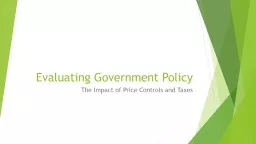

The Impact of Price Controls and Taxes First Tati is sorry she is sick Second Great job today I will post more pics on the website Price Controls pg 30 When the market price appears to ID: 789271
Download The PPT/PDF document "Evaluating Government Policy" is the property of its rightful owner. Permission is granted to download and print the materials on this web site for personal, non-commercial use only, and to display it on your personal computer provided you do not modify the materials and that you retain all copyright notices contained in the materials. By downloading content from our website, you accept the terms of this agreement.
Slide1
Evaluating Government Policy
The Impact of Price Controls and Taxes
Slide2First:
Tati is sorry she is sick.
Slide3Second:
Great job today! I will post more pics on the website!
Slide4Price Controls (pg. 30)
When the
market price
appears to
unfairly hurt either consumers or suppliers
, the
government intervenes
.
However, this can create significant
social costs
.
Examples of price controls:
minimum prices of major food crops (to help farmers)
m
inimum wage or “living wage”
rent controls
Slide5Price Ceilings vs Price Floors
A
price ceiling
is a government-imposed
price control
,
or
limit,
on how
high
a price is charged for a product. Governments intend price ceilings to
protect consumers
from conditions that could make necessary commodities
unattainable
A
price floor
is a government-imposed
price control
on how
low
a price is charged for a product. Governments intend price floors to
protect suppliers
from conditions that could hurt businesses
Slide6P
Q
.
.
Price Ceiling
}
shortage
Price ceilings
are always below equilibrium
Represents the
m
aximum price
a
llowed
– this
helps
consumers
, but
c
reates a
shortage
Slide7P
Q
.
.
Price Floors
Price Floors
are always above equilibrium
Represents the
m
inimum price
a
llowed
– this
helps
p
roducers
, but
c
reates a
surplus
}
surplus
Slide8Rent Control and its effects
Rent control
is an example of a
price ceiling
The government lowers the price of rent to try to help consumers
Effects of rent control:
Shortage
of apartments available
Increase consumer surplus
for the few who are able to find apartments
Reduce producer surplus
of landlords who can’t afford to supply more apartments
Negatively affect other renters
who lose their apartments because landlords can’t afford to supply them anymore
Total surplus is reduced
since rent control prevents some mutually beneficial transactions from taking place (some consumers are willing to rent at higher prices, and suppliers are willing to supply rent at higher prices)
Disruptive effect on the allocation of apartments
, meaning landlords can choose their tenants rather than giving them to individuals who value them most highly (causes inefficiency)
In the short run
, both the supply and demand for housing may be
highly inelastic, but over time they become more elasticLandlords will cut back on maintenance costs
, allowing apartments to deteriorateLow prices will attract more residents to the city
, creating even more excess demand
Slide9In other words, price controls are
no
bueno
.
Slide10Taxes (yay.)
Who bears the burden of paying the tax?
Both consumers and suppliers share the cost of the tax
A tax creates a price wedge between the amount consumers pay and the amount suppliers receive
The effects of tax on consumer and producer surplus:
Prevents mutually beneficial transactions from taking place
This reduction in social welfare is called
deadweight loss
The money that the
gov
makes from taxes reduces total surplus by the same amount
the less elastic the demand/supply curves are:
the greater the share of the tax paid by buyers
the smaller the effect on equilibrium
the lower the deadweight loss
Slide11International Trade
When individuals or countries
specialize
in the activity they do the best, there are
gains from trade
Slide12Production Possibility Frontier (PPF)
A
curve
depicting all maximum
output possibilities
for two or more goods given a set of inputs (resources, labor, etc.). The PPF assumes that all inputs are used efficiently.
Slide13Absolute vs Comparative Advantage
This is so ridiculously easy that I’ll show you in class next time!